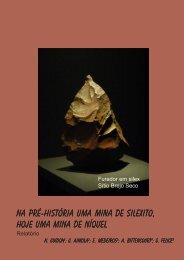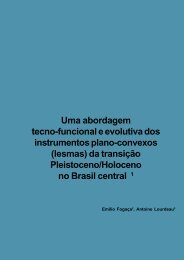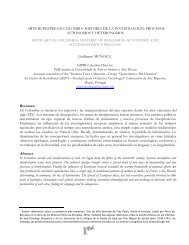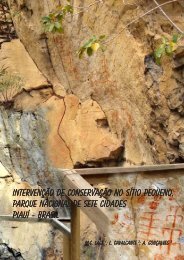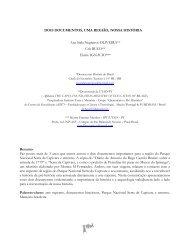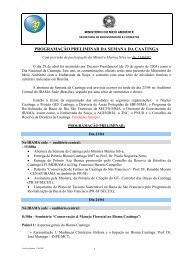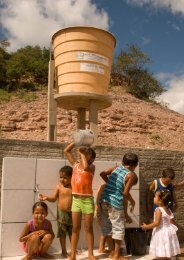Untitled - Fundação Museu do Homem Americano
Untitled - Fundação Museu do Homem Americano
Untitled - Fundação Museu do Homem Americano
Create successful ePaper yourself
Turn your PDF publications into a flip-book with our unique Google optimized e-Paper software.
Global Rock Art Congress<br />
29 Junho – 3 de Julho 2009<br />
Reflections on Rock-art Visualization. Musealization vs “Living Art”?<br />
George Dimitriadis, Grécia<br />
Rock-art from its genesis develop spatial relationships with the surrounding environment. Rock-art as<br />
“living art” of past segmentary societies could be perceived as “a place of negotiation” between men<br />
and things. Rock-art as tangible manifestation of the permanent dialogue between a “given nature” and<br />
a “built nature” is under a constant transformation process stressed by natural and anthropic factors.<br />
Rock-art has an immediate and direct link with its viewers which overlap any musealization proposal.<br />
Consequently, the emerging question is: could be possible musealize rock-art? If yes, when and how?<br />
The concept <strong>Museu</strong>m has a precise connotation and role in western culture after “The New Museology”<br />
movement (1989). In my opinion, an open-air museum could be considered as an adeguate answer to<br />
the musealization approach of rock-art. But, how museologists could propose rock-art to post-industrial<br />
visitors? Is enough learn as more as possible on scientific details during our visit in a rock-art open-air<br />
museum or could be suffient “inspire” the atmosphere which surround rock-art? What time and from<br />
which distance is worth visualize rock-art? What kind of conservation action must be undertaken or not?<br />
Which is the sense of rock-art conservation in nowdays society? Which educational message rock-art<br />
could propose to humankind? Taking in consideration such statements the author try to explore possible<br />
ways of rock-art visualizzazion in a eco-musealizzazion process.<br />
How the time defiance Culture: conservative implications on Madara Horseman rock bas-relief.<br />
A study case on applied monitoring tools.<br />
Nikolai Dobrev, George Dimitriadis - Bulgária & Grécia<br />
Time inexorably deteriorates and consumes rock-cut monuments, prehistoric art compositions and<br />
many open air art pieces. Consequently, emerging crucial sociological questions about the conservation<br />
efficiency, utility and musealisation of such masterpieces have to be solved. How post-industrial societies<br />
replay to the continuous commercialization of culture and natural heritage? How and in which level could<br />
high tech solutions substitute bodily visitor experience of heritage? Both authors had the opportunity to<br />
visit jointly the Madara Horseman bas-relief, which is a famous rock composition from 8 th Century A.C.<br />
inscribed in the World Heritage List of UNESCO and national monument of Bulgaria. During the 12<br />
centuries its existence the monument, carved into the limy sandstone on the western rock wall of the<br />
Madara Plateau, NE Bulgaria, suffered by the obliterated colorization, damaged inscriptions, weathered<br />
and cracked rock. Due to this reason, precise gauges for instrumental monitoring have been installed in<br />
1990-1993 for precise in situ observation of movements along the cracks. The complicated situation of<br />
the monument requires urgent steps for its conservations, protection and fruition.<br />
99<br />
Un Nuevo Sitio con Arte Rupestre en Sapagua, Jujuy, Argentina<br />
Lidia Clara García, Héctor Serafín Lamas - Argentina<br />
La quebrada de Sapagua, Departamento Humahuaca, Provincia de Jujuy, Argentina, forma parte de la<br />
denominada microrregión Azul Pampa. En el Antigal de Alto Sapagua, cercano al sitio presenta<strong>do</strong> acá,<br />
tenemos vestigios de ocupación humana desde el Formativo Final hasta Hispano Indígena. Al Oeste,<br />
se conecta con la quebrada de Inca Cueva, y hacia el E, con Los Pinta<strong>do</strong>s de Sapagua, un paredón<br />
con arte rupestre graba<strong>do</strong> mostran<strong>do</strong> superposiciones de distintos perío<strong>do</strong>s. Tanto Inca Cueva cueva 1<br />
como Los Pinta<strong>do</strong>s, han si<strong>do</strong> objeto de protecciones recientes.<br />
El sitio que presentamos acá, es nove<strong>do</strong>so para la comunidad académica, aunque conoci<strong>do</strong> por los<br />
pobla<strong>do</strong>res locales. Se encuentra bien conserva<strong>do</strong>, y localiza<strong>do</strong> en relación al llama<strong>do</strong> camino de carretas,<br />
incaico, que conecta todas estas localidades. Veinte años atrás, los pobla<strong>do</strong>res no se reconocían como<br />
indígenas. Hoy, Alto Sapagua depende de la comunidad aborígen de Negra Muerta, Inca Cueva de la de<br />
Tres Cruces y Los Pinta<strong>do</strong>s, de la de Hornaditas. El intercambio, dentro del UBACYT F-018 (continuación<br />
de proyectos anteriores) principalmente con la familia Lamas de Alto Sapagua, enriquece nuestra tarea,<br />
y nos planteamos conjuntamente el arma<strong>do</strong> de un centro interpretativo ó museo local.<br />
Parque Nacional Serra da Capivara<br />
Piauí, Brasil




